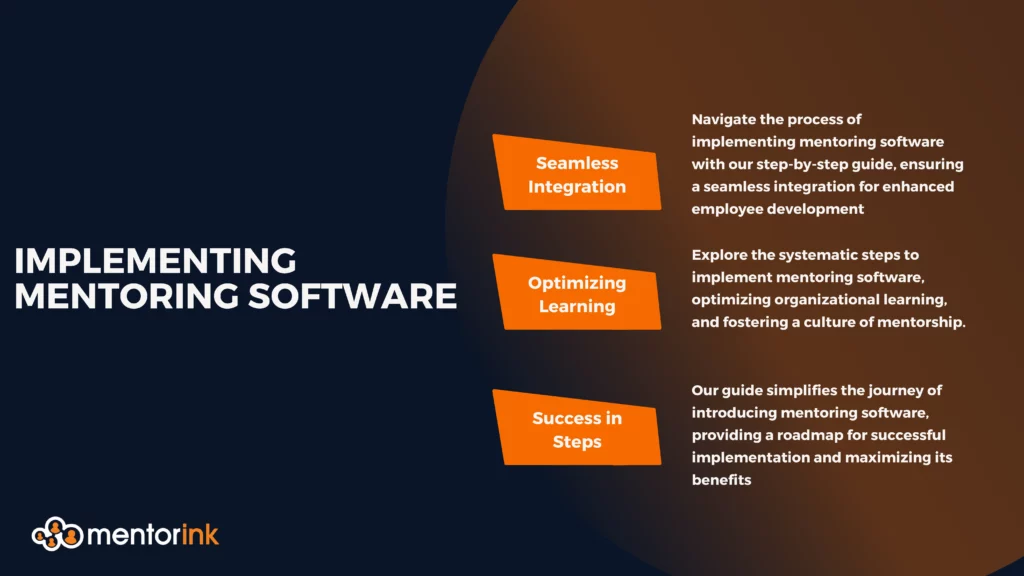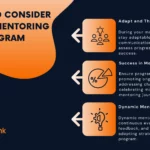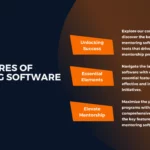
Are you aware of the importance of implementing the mentoring software platform correctly in your organization? We can hear your reply.
If you haven’t chosen the right mentoring software platform for you yet, you should check out this article!
Let’s start to learn step by step how to apply the mentoring software you have to your organization.
Step 1: Define Your Mentoring Goals
Explain why it’s important to define your mentoring goals before selecting a mentoring software 🔍
Here are some specific reasons why it’s important to define your mentoring goals before selecting a mentoring software:
- Clarify Objectives
- Determine Metrics for Success
- Identify Necessary Features
- Optimize Resource Allocation
- Improve Engagement
Therefore, defining your mentoring goals before selecting a mentoring software is important because it helps you choose a software that aligns with your specific needs and objectives. This can ultimately help you achieve better outcomes and optimize resource allocation for your mentoring program.
Provide examples of mentoring goals (e.g. employee development, diversity and inclusion, leadership development) 🖋
Here are some examples of mentoring goals that organizations may have:
- Employee Development: One common mentoring goal is to support the career development of employees. This may involve pairing employees with mentors who can provide guidance, support, and feedback as they work towards achieving their career goals.
- Diversity and Inclusion: Another mentoring goal may be to promote diversity and inclusion within the organization. This may involve pairing employees from diverse backgrounds with mentors who can help them navigate potential barriers and biases within the workplace.
- Leadership Development: A third mentoring goal may be to develop the leadership skills of employees. This may involve pairing high-potential employees with mentors who are experienced leaders and can provide guidance on leadership best practices.
- Onboarding and Integration: Mentoring can also be used to help new employees feel welcome and integrate into the organization. This may involve pairing new hires with mentors who can help them navigate the culture, processes, and expectations of the organization.
- Skill Development: It can also be used to help employees develop specific skills. This may involve pairing employees with mentors who have expertise in the desired skill area and can provide guidance, feedback, and resources to support skill development.
- Succession Planning: Mentoring can also be used to support succession planning within the organization. This may involve pairing employees with mentors who can help them develop the skills and knowledge necessary to take on leadership roles in the future.
Thus, mentoring goals can vary depending on the needs and priorities of the organization. The examples provided above are just a few of the many possible mentoring goals that organizations may have.
Step 2: Choose the Right Mentoring Software
Explain the factors to consider when choosing a mentoring software 👆
Choosing a mentoring software can be a complex decision that requires careful consideration of several factors. Here are some key factors to consider when selecting a mentoring software:
- Features
- Ease of Use
- Cost
- Security
- Integration
- Support
Overall, by taking into account features, ease of use, cost, security, integration, and support, you can select a software that meets your organization’s specific needs and goals.
Step 3: Plan Your Mentoring Program
Explain how to plan a mentoring program using the chosen mentoring software 🗨
Once you have selected a mentoring software that aligns with your mentoring goals and meets the necessary criteria, it’s important to plan out how you will use the software to implement your mentoring program. Here are some steps you can take to plan a mentoring program using the chosen mentoring software:
- Define program objectives: Define the objectives of your mentoring program, including what you hope to achieve and how you will measure success. This will help you determine what features and functionality you need from the mentoring software.
- Identify target audience: Identify the target audience will help you determine the number of users you need to support and how you will match users.
- Determine program structure: Determine the structure of your mentoring program, including how long the program will last, how frequently mentor-mentee pairs will meet, and what types of goals they will set.
- Configure the software: This may involve setting up matching algorithms, customizing mentoring plans, or configuring progress tracking.
- Train users: Train mentors and mentees on how to use the mentoring software effectively. This may involve providing training materials or hosting training sessions.
- Launch the program: This may involve sending invitations to mentors and mentees, providing program guidelines, or scheduling initial mentor-mentee meetings.
- Monitor progress: This will help you assess the program’s effectiveness and identify areas for improvement.
- Make adjustments: Make adjustments to the mentoring program and mentoring software as needed based on feedback from users and program performance data. This will help you optimize the program for success.
To summarize, planning a mentoring program using the chosen mentoring software requires careful consideration of program objectives, target audience, program structure, software configuration, user training, program launch, progress monitoring, and adjustments.
Provide tips for setting up mentor-mentee pairs, creating a mentoring schedule, and setting expectations 🤸🏻
Setting up mentor-mentee pairs, creating a mentoring schedule, and setting expectations are all critical components of a successful mentoring program. Here are some tips:
Setting up Mentor-Mentee Pairs:
- Use a matching algorithm: This can help ensure that mentor-mentee pairs are well-suited to each other and have a strong foundation for a successful mentoring relationship.
- Consider personality and communication style: Mentoring relationships require strong communication and rapport. Therefore pairing individuals who have compatible personalities and communication styles can help ensure a successful mentoring relationship.
- Consider diversity and inclusion: Pairing individuals from different backgrounds and with different perspectives can help promote diversity and inclusion within the organization.
Creating a Mentoring Schedule:
- Determine frequency of meetings: Determine how often mentor-mentee pairs should meet, taking into account the goals of the mentoring program and the availability of both mentors and mentees.
- Establish a timeline: Establish a timeline will help mentors and mentees stay on track and achieve their goals.
- Be flexible: Life and work can be unpredictable, so mentor-mentee pairs should have some flexibility in their schedule to accommodate unforeseen events.
Setting Expectations:
- Establish clear goals: This will help ensure that everyone is on the same page and working towards the same objectives.
- Set expectations for communication: Set expectations for how mentors and mentees will communicate with each other. This could include the preferred method of communication, response times, and frequency of communication.
- Establish accountability: This will help ensure that mentors and mentees are making progress towards their objectives and staying on track.
By following these tips, you can help ensure that mentor-mentee pairs are well-suited to each other. Also you can help ensure the mentoring schedule is effective, and expectations are clear and realistic.
Step 4: Launch Your Mentoring Program
Explain how to launch the mentoring program and communicate it to employees ⏳
Here are some steps to follow when launching a mentoring program and communicating it to employees:
- Develop a communication plan: Develop a communication plan that outlines how you will communicate the mentoring program to employees. This could include emails, posters, or social media posts.
- Use multiple channels: Consider using email, newsletters, intranet pages, and social media to reach as many employees as possible.
- Highlight program benefits: Highlight the benefits of the mentoring program, such as career development opportunities, skill-building, and the chance to learn from experienced professionals. This will help employees see the value of the program and encourage them to participate.
- Explain program objectives: Explain the program objectives and how they align with the company’s overall goals. This will help employees understand how the program fits into the company’s larger strategy.
- Provide program details: Provide program details, such as how to sign up, the expected time commitment, and the types of mentoring relationships that will be available. This will help employees understand what to expect and how to participate.
- Answer questions: Be prepared to answer questions about the program. Hold information sessions or Q&A sessions to help employees learn more about the program and how to participate.
- Launch the program: Launch the mentoring program with a kickoff event or ceremony. This could include a keynote speaker, a networking session, or a panel discussion. This will help generate excitement and enthusiasm for the program.
- Provide ongoing support: Provide ongoing support to participants throughout the mentoring program. This could include check-ins, progress tracking, and additional resources to help participants achieve their goals.
By following these steps, you can launch the mentoring program and communicate it to employees effectively. Hence, this will help ensure that the program is successful and that employees are engaged and motivated to participate.
Provide tips for creating excitement and engagement around the program 🔢
Creating excitement and engagement around the mentoring program is crucial for its success. Here are some tips for creating excitement and engagement around the program:
- Host a kickoff event: Host a kickoff event to launch the program and generate excitement. This could include a keynote speaker, networking opportunities, or a panel discussion.
- Use storytelling: Use storytelling to highlight the benefits of the mentoring program. Share success stories from past participants to show how the program has helped them grow and develop in their careers.
- Provide training: Provide training to mentors and mentees to help them build the skills they need to be successful in their mentoring relationships. This could include training on communication, goal-setting, or feedback.
- Encourage communication: Encourage communication between mentors and mentees to help them build strong relationships. Provide opportunities for them to connect and network, such as virtual coffee chats or networking events.
- Recognize achievements: Recognize the achievements of mentors and mentees throughout the program. This could include awards, certificates, or public recognition for their hard work and progress.
- Provide ongoing support: Provide ongoing support to mentors and mentees throughout the program. This could include check-ins, progress tracking, and additional resources to help participants achieve their goals.
- Foster a culture of learning: Foster a culture of learning within the organization by highlighting the importance of professional development and career growth. This will help employees see the value of the mentoring program and encourage them to participate.
- Celebrate the program’s success: Host a closing event or ceremony to recognize the achievements of mentors and mentees and to showcase the impact of the program.
Overall, encouraging communication, recognizing achievements, and fostering a culture of learning will help employees see the value of the program and encourage them to participate.
Step 5: Evaluate and Refine Your Mentoring Program in Your Organization
Explain why it’s important to evaluate the mentoring program and make adjustments as needed
Here are some reasons why it’s important to evaluate the mentoring program:
- Identify areas for improvement: By collecting feedback from mentors and mentees, you can identify any challenges or issues that need to be addressed.
- Measure program effectiveness: By tracking progress and outcomes, you can determine whether the program is meeting its goals and objectives.
- Ensure program relevance: By regularly assessing the program’s relevance to the organization’s goals and objectives, you can ensure that it continues to meet the needs of the organization and its employees.
- Enhance program impact: By making adjustments based on feedback and outcomes, you can improve the program and increase its impact on participants and the organization.
- Increase program engagement: By collecting feedback from mentors and mentees and making adjustments based on their needs and preferences, you can increase engagement and participation in the program.
- Demonstrate program value: By collecting data on the program’s impact and outcomes, you can demonstrate its value to stakeholders, including senior leadership, investors, and employees.
Thus, by evaluating the mentoring program and making adjustments as needed, you can ensure that the program remains relevant, effective, and engaging for participants. This will help to maximize its impact on employees and the organization as a whole.
Provide tips for collecting feedback and measuring the success of the program
Here are some tips for collecting feedback and measuring the success of the program:
- Use surveys: Surveys are a useful tool for collecting feedback from mentors and mentees. Consider using both quantitative and qualitative questions to get a well-rounded understanding of their experiences.
- Collect data on outcomes: Collect data on outcomes such as increased job satisfaction, improved performance, and promotions. This can help you measure the impact of the program and demonstrate its value.
- Use data analytics: This can help you identify any patterns or trends in their behavior and outcomes.
- Hold focus groups: This can help you get a better understanding of their experiences and identify any areas for improvement.
- Track participation rates: This can help you identify any barriers to participation and find ways to increase engagement.
- Solicit feedback from managers: This can help you identify any organizational benefits of the program.
- Use a mix of methods: Use a mix of methods to collect feedback and measure success. Combining surveys, data analytics, and focus groups can give you a well-rounded understanding of the program’s impact.
Overall, by collecting feedback and measuring the success of the mentoring program, you can identify areas for improvement, measure the impact of the program. Also increase engagement among mentors and mentees. This will help you to continuously improve the program and ensure its long-term success.
Conclusion
Encourage readers to implement a mentoring program in their organization using the step-by-step guide
Implementing a mentoring program in your organization can have numerous benefits, such as increased employee development, diversity and inclusion, and leadership development. With the step-by-step guide provided in this post, you can successfully implement a mentoring program using mentoring software that aligns with your program objectives, while also ensuring the program is engaging and effective.
Remember to define your mentoring goals, consider the factors when choosing a mentoring software, plan the mentoring program, launch the program with excitement and engagement, evaluate the program, and collect feedback to measure its success. By following these steps, you can create a mentoring program that benefits both mentors and mentees, while also enhancing the overall productivity and success of your organization.
Don’t wait any longer to implement a mentoring program in your organization. Use this step-by-step guide to get started today!
Sounds exciting?
We would be very happy to support your design and run your mentoring programs
Book your Demo

